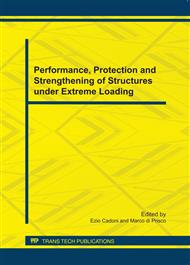[1]
G.C. Mays, J.G. Hetherington, T.A. Rose, Response to blast loading of concrete wall panels with openings. J. Struct. Engrg., 125 (1999) 1448-1450.
DOI: 10.1061/(asce)0733-9445(1999)125:12(1448)
Google Scholar
[2]
B.M. Luccioni , M. Luege, Concrete pavement slab under blast loads, International, Journal of Impact Engineering, 32 (2006) 1248-1266.
DOI: 10.1016/j.ijimpeng.2004.09.005
Google Scholar
[3]
TM 5-855-1. Fundamentals of Protective Design for Conventional Weapons. U.S. Department of the Army, (1986).
Google Scholar
[4]
UFC 3-340-02. Unified Facilities Criteria (UFC) - Structures to resist the effects of accidental explosions. HQUSACE, NAVFAC and AFCESA, (2008).
DOI: 10.1061/41171(401)127
Google Scholar
[5]
R.D. Ambrosini, B.M. Luccioni, R.F. Danesi, J.D. Riera, M.M. Rocha, Size of craters produced by explosive charges on or above the ground surface, Shock Waves, 12 (2002) 69–78.
DOI: 10.1007/s00193-002-0136-3
Google Scholar
[6]
C. Wu, Y. Lu, H. Hao, W.K. Lim, Y. Zhou, C.C. Seah, Characterisation of underground blast-induced ground motions from large-scale field tests, Shock Waves, 13 (2003) 237–252.
DOI: 10.1007/s00193-003-0212-3
Google Scholar
[7]
S. Kobielak, T. Krauthammer, Dynamic response of buried silo caused by underground explosion, Shock and Vibration, 11 (2004) 665–684.
DOI: 10.1155/2004/507650
Google Scholar
[8]
W.E. Baker, P.A. Cox, P.S. Westine, J.J. Kulesz, R.A. Strelhow, Explosion Hazards and Evaluation. Elsevier, Amsterdam, (1983).
Google Scholar
[9]
Y. Lu, H. Hao, G. Ma, Experimental investigation of structural response to generalized ground shock excitations, Experimental Mechanics, 42 (2002) 261–271.
DOI: 10.1007/bf02410981
Google Scholar
[10]
H. Liu, Dynamic analysis of subway structures under blast loading, Geotechnical and Geological Engineering, 27 (2009), 699–711.
DOI: 10.1007/s10706-009-9269-9
Google Scholar
[11]
S. Foti, Surface Wave Testing for Geotechnical Characterization. In Surface Waves in Geomechanics: Direct and Inverse Modelling for Soils and Rocks., CISM Series, N. 481, Lai C.G. and Wilmanski K. eds, Springer, Wien. 47-71, (2005).
DOI: 10.1007/3-211-38065-5_2
Google Scholar
[12]
A.W. Skempton, Standard penetration test procedures and the effects in sands of overburden pressure, relative density, particle size, aging and overconsolidation, Geotechnique, 3 (1986) 425–447.
DOI: 10.1680/geot.1986.36.3.425
Google Scholar
[13]
J. H. Schmertmann, Guidelines for cone penetration test, performance and design. Report fhwa-ts-78-209. Technical report, Federal Highway administration, Washington, (1978).
Google Scholar
[14]
J. E. Bowles, Foundation Analysis and Design. McGraw-Hill, (1996).
Google Scholar


